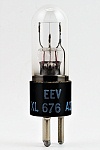Lampes à arc de tungstène
Tungsten arc lamps
Wolfram-Bogen-Lampen

Afin de donner à l'arc la même commodité d'emploi que celle des lampes à incandescence, on a imaginé de le faire jaillir entre deux électrodes de tungstène placées dans une ampoule remplie d'un gaz inerte (azote ou argon). La distance entre électrodes est en général de 2 à 3 mm. La pression dans ces lampes est de 80 à 180 mm de Hg.
Il en existe divers types, dont l'allumage peut être effectué:
• par émission thermionique au moyen d'un filament émissif auxiliaire préalablement chauffé;
• par le passage d'une décharge à haute tension de courte durée permettant l'ionisation du gaz entre les électrodes;
• en mettant les électrodes en contact au moment de l'allumage et en les séparant ensuite, ainsi que cela se faisait dans le cas d'un arc entre charbons; ce mode d'allumage s'effectue généralement à l'aide d'un bilame;
• par ionisation due à une décharge à lueur entre deux électrodes auxiliaires ayant une résistance élevée en série.
En fonctionnement, les boules sont lumineuses, leur température de couleur est d'environ 3000°K.
Ces arcs peuvent fonctionner aussi bien en courant continu qu'en courant alternatif.
Leur utilisation était limitée aux appareils d'optique dans lesquels on désire obtenir une luminance élevée assez uniforme (éclairage de microscopes, microprojection, éclairage de fentes).

Pointolite lamps, with a brightness intermediate between that of the incandescent filament lamp and the carbon arc, are described as arc-incandescent lamps, as they have physical properties not unlike those of the arc, and constructional features similar to those of a tungsten filament lamp. They are made with either two or three electrodes for D.C. operation, while another design is used for A.C. supplies.
In the two-electrode lamp, the light is emitted from a spherical tungsten ball which forms the anode. The cathode consists of a tungsten spiral extending into a tube made from a mixture of tungsten and thorium oxide. The arc strikes initially between the spiral and the ball, but immediately afterwards it transfers from the spiral to the tube, on which it runs permanently. The bulb is normally filled with a mixture of argon and nitrogen.
In another construction, the ball is mounted on a bimetallic strip which moves as soon as the arc has struck to facilitate its transfer.
More powerful lamps employ three electrodes consisting of a bead, an ioniser and a plate. The arc starts between the ioniser (negative) and the bead (positive), with the plate disconnected. The ioniser is then disconnected by a rotary switch, and at the same time the incandescent bead is made negative and the plate positive so that the arc operates between the bead and the plate, the latter forming the light source.
In the A.C. Pointolite, the plate is replaced by a second bead, the same size as the first, and both beads are equally bright.
The Pointolite lamps give a continuous spectrum similar in nature to that from a filament lamp. They were used chiefly in optical instruments, but have been superseded by mercury vapour projector lamps in many cases, as the latter are more convenient to operate and have a much higher brightness.
 |
 |
 |
 |
 |
 |
 |
|
AEI EDISWAN Pointolite 150 C.P. |
EEV XL676-A2T |
GENERAL ELECTRIC 30A 11V |
Philips 406 2.5A |
Philips 407 65W 2.5A |
Royal Ediswan Pointolite 100 C.P. |
Royal Ediswan Pointolite 150 C.P. |
|
Le contenu de ce site est sous copyleft  The content of this site is under copyleft
The content of this site is under copyleft  Der Inhalt dieser Website steht unter Copyleft
Der Inhalt dieser Website steht unter Copyleft
